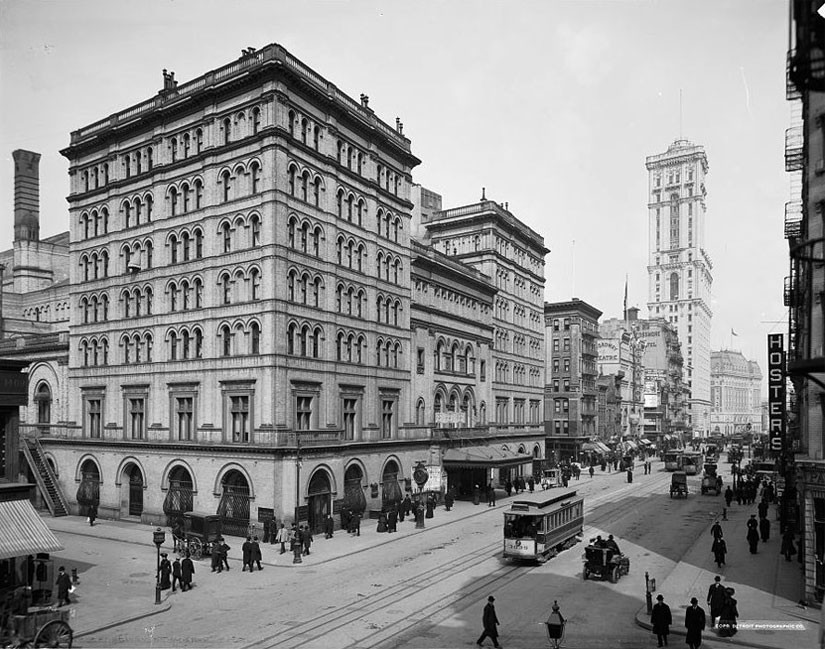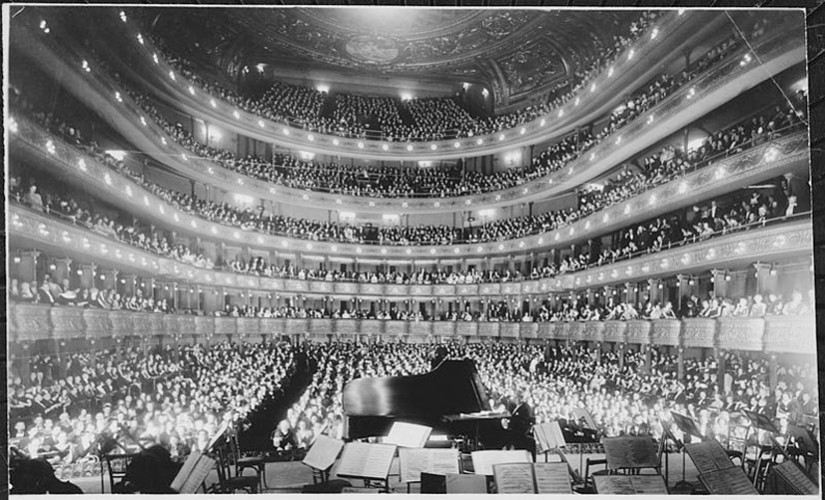
“Old” Metropolitan Opera House
The demolition of the “Old” Metropolitan Opera House was the first loss of a potential landmark since the New York City Landmarks Law was passed in 1965.
In 1880, dissatisfied with the location and seating capacity of the 1854 Academy of Music opera house near Union Square, a group of wealthy businessmen opted to build their own. In all, 70 shareholders provided the $1.7 million required to buy the land and build the opera house at West 39th Street and Broadway.1 Occupying the entire western side of the block between West 39th Street and West 40th Street, the “Old” Metropolitan Opera House opened on October 22, 1883. Designed by J. C. Cady, it was nicknamed “The Yellow Brick Brewery” for its industrial looking exterior.2 However, others found the “Old” Metropolitan Opera House’s intimate interior appealing. “I miss that house and not that I’m a great fan of opera but – that house, when you sit on the stage the balconies went straight up and they were only about 15-20 rows back – they were very short,” said Bronson Binger.
“You were sitting in this wonderful sea of faces – it was like being in a drawing room.”3
The theater was gutted by fire in August 1892, but was rebuilt over the next two years along its original lines. In the early 1900s, the opera house underwent another series of transformations. The interior was redesigned in 1903, and in 1906, the signature gold damask stage curtains were installed, completing the look that the “Old” Metropolitan Opera House maintained until its closing.
The theater came under threat of demolition in 1938, but $1 million in gifts from the public saved the house.4 In 1940, ownership of the opera house shifted from the theater’s box owners to the Metropolitan Opera Association. Ironically, the Metropolitan Opera Association would prove “rapacious,” becoming the “main force” against the preservation of the old opera house.5
In the early 1960s, the plans for Lincoln Center promised the Metropolitan Opera a new location for their opera house. A new opera house would provide more seats, larger facilities, and new technology, not to mention an opportunity for the company to rebound financially.6 The Metropolitan Opera Association planned to raze the opera house and lease the property. But in September 1965, the newly formed New York City Landmarks Preservation Commission included the opera house on its first list of proposed designated landmarks. However, the Commissioners ultimately voted 6 to 5 not to designate the building.7 Some were surprised by this decision and called it “a very close vote considering the questionable quality of the architecture and the opposition from the opera company.8 The Metropolitan Opera Association adamantly resisted preservation, in part because it feared competition from another opera company.9
A bitter battle ensued between preservationists and the opera house’s management. Mayor John V. Lindsay and Governor Nelson A. Rockefeller became involved and established the Citizen’s Committee for the Preservation of the Metropolitan Opera House. But the Metropolitan Opera Association sued (eventually winning) and serious preservation efforts were terminated in August 1966. The “Old” Metropolitan Opera House was demolished in January 1967. It was the first loss of a potential landmark since the New York City Landmarks Law was passed in 1965.
The "Old" Metropolitan Opera House was among the first structures to be considered by the New York City Landmarks Preservation Commission for landmark status in 1965. However, after a scramble to preserve it, the opera house was destroyed with the Commission's consent in January 1967. In 1970, the World Apparel Center was built on the site.
1883: The "Old" Metropolitan Opera House is constructed at West 39th Street and Broadway
1938: Threatened with demolition, the theater is saved by $1 million in gifts from the public10
September 1965: The Landmarks Preservation Commission includes the building in its list of proposed landmarks at its first public hearing11
January 1967: The "Old" Metropolitan Opera House is demolished
Bronson Binger played a large role in the attempts to preserve the opera house. Binger was an architect who served as secretary of the Citizen’s Committee for the Preservation of the Metropolitan Opera House, and spent “eighteen months literally working full-time” in hopes of preserving the building. In the process, he ran into the Municipal Art Society and got them to “more or less endorse the idea of saving the old Metropolitan Opera House.”12 “We were interested in just saving it as is and restoring as little as possible,” he said. “The idea was to keep it open. I think today we would have had a better chance of saving it than we did then. Part of the problem then was that politically it was not a popular thing to do.”13
On April 6, 1966, a group including Leonard Bernstein, Gian Carlo Menotti, Tony Randall, and Marian Anderson announced a plan to raise $8 million to buy the hall from the Metropolitan Opera Association, and an additional $12 to $14 million to renovate it. But the Metropolitan Opera Association said the lease payments would equal $12 million, a figure it would later raise to $15 million.14 Ten days later, on closing night, the conductor Leopold Stokowski made an unexpected plea from the podium:
"I beg you to save this magnificent house."15
At the same time, there was also considerable controversy over whether the opera house should be preserved with greater emphasis on its exterior or interior. The "Old" Metropolitan Opera House was an admittedly plain building on the exterior. Some have gone so far as to call the building's exterior “famously ugly.”16 Another described the opera house as a “third rate warehouse.”17 This fact had a great influence in 1965 when the building came before the New York City Landmarks Preservation Commission. The lack of aesthetic beauty took “precedence over any consideration of the building’s historic and cultural significance” and the Commission voted against designation.”18 Without designation, the "Old" Metropolitan Opera House was demolished in 1967.
However, this was not the end of the discussion regarding the building. In 1973, an amendment was added to the 1965 Landmarks Law that would allow the Commission to designate publicly-accessible interiors. This amendment would only apply to buildings with “interiors that are ‘customarily open’ or accessible to the public,” as was the interior of the opera house.”19 The loss of the "Old" Metropolitan Opera House was used numerous times as an example of why the amendment to the law was necessary.

- Oral Histories with Bronson Binger and Mosette Broderick
New York Preservation Archive Project
174 East 80th Street
New York, NY 10075
Tel: (212) 988-8379
Email: info@nypap.org
- Ed Dinger. “The Metropolitan Opera” Accessed: June 29, 2009.
- NYPAP, “Bronson Binger Interview with Melissa Brunette,” October 17, 2008.
- John Briggs, Requiem for a Yellow Brick Brewery: A History of the Metropolitan Opera (Boston: Little, Brown, 1969), p. 359.
- Christopher Gray, “Streetscapes/The old Metropolitan Opera House; Why Mimi No Longer Dies at Broadway and 39th,” The New York Times, 23 April 1995.
- Ibid.
- Ed Dinger. “The Metropolitan Opera” Accessed: June 29, 2009.
- Christopher Gray, “Streetscapes/The old Metropolitan Opera House; Why Mimi No Longer Dies at Broadway and 39th,” The New York Times, 23 April 1995.
- Ibid.
- Ibid.
- Christopher Gray, “Streetscapes/The old Metropolitan Opera House; Why Mimi No Longer Dies at Broadway and 39th,” The New York Times, 23 April 1995.
- “Landmark Drive to Open Sept. 21,” The New York Times, 7 September 1965.
- NYPAP, Bronson Binger Interview with Melissa Brunette, October 17, 2008.
- Ibid.
- Christopher Gray, “Streetscapes/The old Metropolitan Opera House; Why Mimi No Longer Dies at Broadway and 39th,” The New York Times, 23 April 1995.
- Ibid.
- Gregory Gilmartin, Shaping the City: New York and the Municipal Art Society (New York: Clarkson N. Potter, 1995).
- Ronald Maiorana, “Save-Met Drive Suffers Setback,” The New York Times, 17 January 1967
- Ibid.
- Paul Goldberger, “City Acts to Protect Interiors of Historic Buildings,” The New York Times, 2 November 1973.